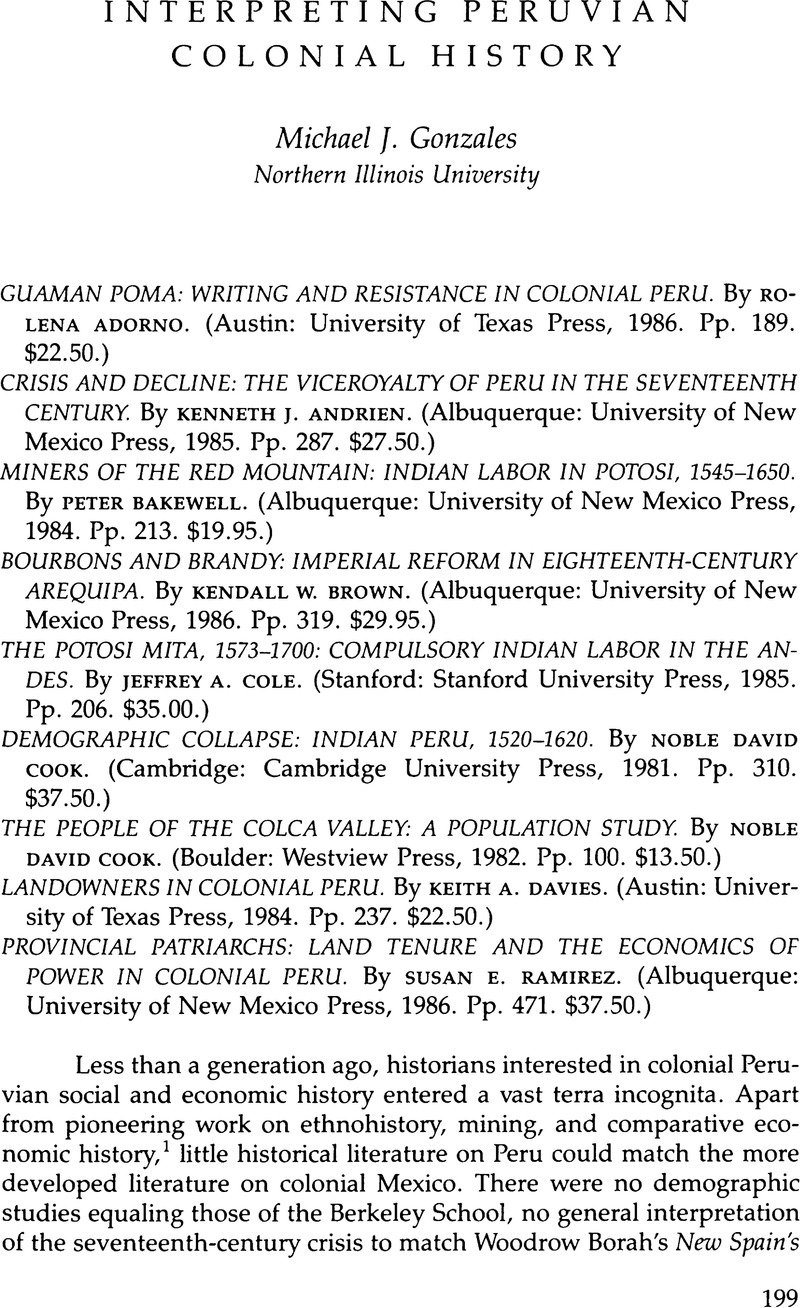No CrossRef data available.
Article contents
Interpreting Peruvian Colonial History
Review products
Published online by Cambridge University Press: 12 October 2022
Abstract

- Type
- Review Essays
- Information
- Copyright
- Copyright © 1988 by Latin American Research Review
References
Notes
1. John V. Murra, “The Economic Organization of the Inca State,” Ph.D. diss., University of Chicago, 1956, now available as La organización económica del estado Inca (Mexico City: 1978). See also John H. Rowe, “Inca Culture at the Time of the Spanish Conquest,” Handbook of South American Indians, edited by Julian Steward (Washington, D.C.: U.S. Printing Office, 1946), 2:183-330; George Kubler, “The Quechua in the Colonial World,” Handbook of South American Indians 2:331-411; Guillermo Lohmann Villena, Las minas de Huancavelica en los siglos XVI y XVII (Seville: 1949); Arthur P. Whitaker, The Huancavelica Mercury Mine: A Contribution to the History of the Bourbon Renaissance in the Spanish Empire (Cambridge, Mass.: 1941); and Guillermo Céspedes del Castillo, “Lima y Buenos Aires: repercusiones económicas y políticas de la creación del Virreinato del Plata,” Anuario de Estudios Americanos 3 (1946):669–874.
2. For a review of much of the recent literature on rural history, see Eric Van Young, “Mexican Rural History since Chevalier: The Historiography of the Colonial Hacienda,” LARR 18, no. 3 (1983):5–61.
3. For example, see John V. Murra, Formaciones económicas y políticas del mundo andino (Lima: 1975); Nicolás Sánchez-Albornoz, Indios y tributos en el Alto Perú (Lima: 1975); Franklin Pease G. Y., Del Tawantinsuyu a la historia del Perú (Lima: 1978); Karen Spalding, Huarochirí: An Andean Society under Inca and Spanish Rule (Stanford: 1984); Steve J. Stern, Peru's Indian Peoples and the Challenge of Spanish Conquest: Huamanga to 1640 (Madison: 1982); Nathan Wachtel, La visión des vaincus: les indiens du Pérou devant la conquête espagnole (Paris: 1971); James Lockhart, Spanish Peru, 1532-1560 (Madison: 1968); Frederick P. Bowser, The African Slave in Colonial Peru, 1524-1650 (Stanford: 1974); Manuel Burga, De la encomienda a la hacienda capitalista: el valle de Jequetepeque del siglo XVI al XX (Lima: 1976); Robert G. Keith, Conquest and Agrarian Change: The Emergence of the Hacienda System on the Peruvian Coast (Cambridge, Mass.: 1976); Nicholas P. Cushner, Lords of the Land: Sugar, Wine, and Jesuit Estates of Coastal Peru, 1600-1767 (Albany, N.Y.: 1980); and Carlos Sempat Assadourian, El sistema de la economía colonial: mercado interno, regiones y espacio económico (Lima: 1982).




